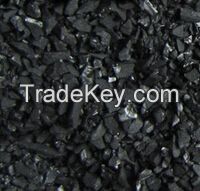Description
The raw materials of water treatment activated carbon have coconut
shells, walnut shell, apricot, peach shell, wood, coal and so on,
the coconut shell activated carbon is considered the best water
treatment activated carbon. Water treatment activated carbon has
powder, granule and columnar, among them granule is the most widely
used. The smaller granularity, the faster absorption, but head loss
increases, usually in ***0 mesh is better.
Yuanying water treatment activated carbon has three merits: large
adsorption capacity, quick adsorption rate, good mechanical
strength. In addition, activated carbon has large specific surface
area, abundant pore structure, not easy off powder, low base layer
resistance, chemical stability, high degree of purification, long
service life, easy regeneration.
Due to the adsorption process and action principle of activated
carbon water treatment involves more complex, so there are a lot of
influence factors. The main factors include the properties of
activated carbon, pollutants properties in water, solution PH,
solution temperature, carbon treatment process principle, selective
operating parameters and operating conditions.
Activated carbon adsorption capacity is mainly related to its
specific surface area, the greater specific surface area is, the
better adsorption property is. Adsorption rate is mainly related to
grain size and pores distribution of activated carbon. Water
treatment activated carbon requires abundant transition hole
(radius is *0 to ***0 angstroms), that is conducive to the
adsorbate (pollutants in water) spreads to the hole. In addition,
activated carbon surface chemical properties, polarity and electric
charge also affect the adsorption effect.
Application
Activated carbon surface has a large number of functional groups
such as hydroxyl and carboxyl, can undertake chemical adsorption
and electrostatic attraction to various organic substances.
Activated carbon can remove the organic substances such as humic
acid, fulvie acid, lignosulfonic acid etc. which are harmful to
anion exchange agent; also can remove the substances such as free
chlorine residual which is harmful to cation exchanger. Generally,
activated carbon can remove *3%**8% colloidal substances, around
*0% ferrum, *7%**0% organic substances. Activated carbon has strong
adsorption capacity to water dissolved organic contaminants, such
as benzenes, phenols, petroleum and petroleum products. Organic
pollutants by biological method and chemical method is difficult to
remove, such as chrominance, foreign odor, methylene blue surface
active substances, herbicides, pesticides, agricultural chemicals,
synthetic detergents, synthetic dyes, amine compounds, and many
synthetic organic compounds, activated carbon have good effect to
removal them. Activated carbon has strong adsorption capacity to
some heavy metal compounds, such as mercury, plumbum, ferrum,
nickel, chromium, zinc, cobalt, etc., therefore, activated carbon
has a good effect to electroplating wastewater and treatment
smelting wastewater treatment. Activated carbon is widely used for
domestic water and food industry, chemical industry, electric power
industry, etc. for water purification, dechlorination, oil removal
and deodorization.
